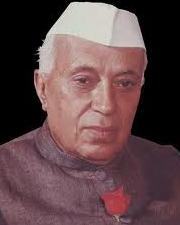 Pandit Jawaharlal Nehru (1889 - 1964) was one of the prominent leaders of Indian freedom struggle. He was the favourite disciple of Gandhiji and later became the first Prime Minister of India. Nehru is widely recognized as the architect of modern India. He had spent almost 14 years of his life in prison during India’s freedom struggle. After his studies in England, Jawaharlal Nehru returned to India in 1912 as a barrister. He married Kamala Nehru in 1916. In 1917, he joined Home Rule League. His became active in politics after meeting Mahatma Gandhi in 1919. At that time Gandhi had launched a campaign against Rowlatt Act. Nehru was instantly attracted to Gandhi's commitment for active but peaceful, non-co-operation movement (1920-1922). He actively participated in the movement and was arrested twice in connection with the Non-Cooperation Movement of 1920-22.
He organised the first Kisan March in Pratapgarh District of Uttar Pradesh in 1920.
Pandit Jawaharlal Nehru (1889 - 1964) was one of the prominent leaders of Indian freedom struggle. He was the favourite disciple of Gandhiji and later became the first Prime Minister of India. Nehru is widely recognized as the architect of modern India. He had spent almost 14 years of his life in prison during India’s freedom struggle. After his studies in England, Jawaharlal Nehru returned to India in 1912 as a barrister. He married Kamala Nehru in 1916. In 1917, he joined Home Rule League. His became active in politics after meeting Mahatma Gandhi in 1919. At that time Gandhi had launched a campaign against Rowlatt Act. Nehru was instantly attracted to Gandhi's commitment for active but peaceful, non-co-operation movement (1920-1922). He actively participated in the movement and was arrested twice in connection with the Non-Cooperation Movement of 1920-22.
He organised the first Kisan March in Pratapgarh District of Uttar Pradesh in 1920.
Nehru became the General Secretary of the All India Congress Committee in 1923.
In 1924, Nehru was elected President of the Allahabad Municipal Corporation, and served for two years as the city's chief executive. He resigned in 1926 citing lack of cooperation from civil servants and obstruction from British authorities.
In 1928-29, the Congress's annual session under President Motilal Nehru, his father, was held. During that session Nehru and Subhas Chandra Bose backed a call for full political independence, while Motilal Nehru and others wanted dominion status within the British Empire. To resolve the point, Gandhi said that the British would be given two years to grant India dominion status. If they did not, the Congress would launch a national struggle for full, political independence. Nehru and Bose reduced the time of opportunity to one year. The same year, he also founded the 'Independence for India League', which advocated complete severance of the British connection with India, and became its General Secretary.
In December 1929, Congress's annual session was held in Lahore and Jawaharlal Nehru was elected as the President of the Congress Party. During that sessions a resolution demanding India's independence was passed and on January 26, 1930 in Lahore, Jawaharlal Nehru unfurled free India's flag. Gandhiji gave a call for Civil Disobedience Movement in 1930. The movement was a great success and forced British Government to acknowledge the need for major political reforms. He completed his 'Autobiography' in Almora Jail in 1935.
When the British promulgated the Government of India Act 1935, the Congress Party contested in the elections. Nehru stayed out of the elections, but campaigned vigorously nationwide for the party. The Congress formed governments in almost every province, and won the largest number of seats in the Central Assembly. Nehru was elected to the Congress presidency in 1936, 1937, and 1946, and came to occupy a position in the nationalist movement second only to that of Gandhi. He was arrested in 1942 during Quit India Movement. Released in 1945, he took a leading part in the negotiations that resulted in the emergence of the dominions of India and Pakistan in August 1947.
You might also interested in





0 comments: